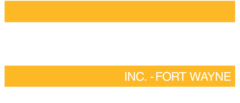Guide to Industrial & Factory Painting
Preferred, Inc. - Fort Wayne lays down the layers of information you need to create a solid base for your project.
Go into Your Project Informed and Save Money
Painting projects can be complex and costly. In recent years, industrial facilities have put aside more space in the budget for maintenance. Yet, facilities managers often hesitate to commit to a large-scale painting project. When they do move forward, they often find the RFP process to be slow and complex. Some vendors overpromise and under-deliver, leading to problems in the future. When the project is done right, it adds a lot of value – but when it’s done wrong, it can hurt your business for a long time to come. After reading this article and applying the insights we teach here, you’ll be able to ensure you do a great job for your company.
We at Preferred, Inc. – Fort Wayne understand that a major industrial painting project can be a daunting task. With that in mind, we’ve developed a step-by-step guide that breaks down every aspect into manageable tasks. We leveraged nearly 40 years of experience in challenging industrial paint projects to develop every portion of this guide. The material covered has been informed by feedback from hundreds of satisfied clients.
Getting the return you expect on your painting project requires clarity of your goals from start to finish. Yet, until now, there’s been no comprehensive resource to make this possible. Industrial painting is a crowded industry, and not every contractor will be right for you. We believe that every client should have the opportunity to make an informed decision. We are confident that, with the help of our guide and the included resources, you’ll be equipped for lasting success on your painting project, even if you have never needed one before.
In addition, we’ve included checklists and resources you can use right away: A Statement of Work template, Contractor Interview Questionnaire, and Paint Project Audit Checklist.
Part 1
Professionals Answer Questions on Painting ROI
Painting isn’t a high priority in today’s factory budgets, but perhaps it should be.
A complete industrial painting job serves to revitalize a facility and support top quality performance. Factory painting isn’t just about looks, it’s about making an investment that will strengthen your ability to deliver world-class results.
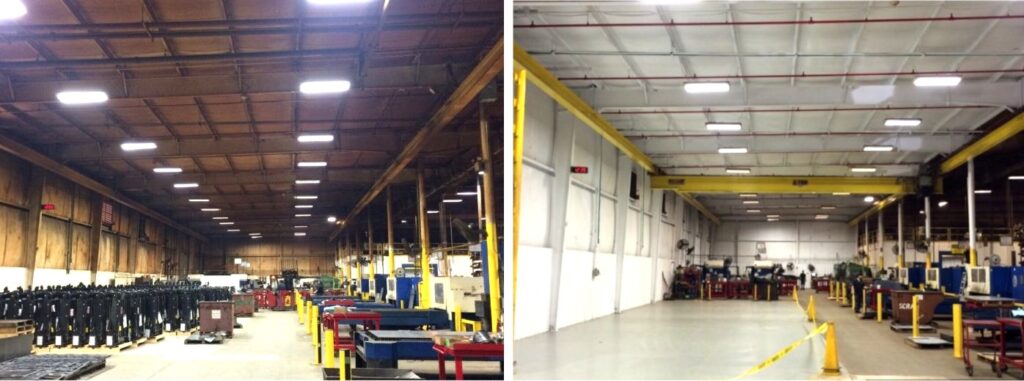
Painting your factory pays off in four distinct ways:
1. Morale
A team’s morale and focus on the job is strongly affected by the environment. If the facilities look run down and worn out, people will simply not take their work as seriously. This especially affects new or inexperienced employees who are not yet invested in your mission.
A new paint job is a visible and comprehensive way to show you take pride in your work. It helps you attract good employees by demonstrating your commitment to excellence. Plus, it will shake the team out of complacency so they stay alert to safety issues and areas for improvement.
2. Tour Routes
If there are public-facing areas of your facility, they represent your brand to the world. A paint project ensures that your brand’s image of quality, safety, and customer focus shines through in every element of your work area – boosting the confidence of your customers and end users.
In today’s high-tech world, people are fascinated by the inner workings of manufacturing sites. Plus, the most discerning clients will want to see your facilities up close before making an agreement with you. A fresh coat of paint shows you are ready for what the future holds.
3. Inspection
In some industries, such as food, the slightest appearance of chipped paint or rust can throw your entire business model into doubt. Inspectors from institutions like AIB International, the FDA, and APHIS have the power to levy significant fines or even shut down your operation for infractions that might seem minor at first.
Even if your compliance standards aren’t as strict, it’s a good idea to work one step above what’s necessary. Painting helps prepare you for a pivot to rules-driven industries like medical devices – which are huge profit engines.
4. Performance
Painting can improve the performance of equipment. The right materials, applied in the right ways by experts, can save you thousands of dollars in maintenance costs down the road. That’s particularly true when rust-proofing steel components and leak-proofing tanks.
Since painting adds to the longevity of your equipment, you’ll often find that smaller painting projects break even over a time horizon of just a few years. Painting your components today is much less costly – and far less disruptive – than replacing them in a year or two.
Painting ROI: Right Way, Wrong Way
Let’s look in on two facilities managers, Jim and Rob.
Jim doesn’t know much about the value of industrial painting. He “goes with his gut” and does whatever seems right at the time. Painting hasn’t been a priority at his factory, so he already has rust and other issues that desperately need painting when he starts on his project.
Rob understands the value of having a well-painted industrial facility. He knows the research, planning, and communication that goes into planning these projects is worth it. Since he knows the value of these projects, he communicates the value to his company. His budget is approved.
Remember:
- Industrial painting affects your performance, your team, and even your customers.
- Taking a step-by-step approach will help you get the job done right, start to end.
- Doing your research first saves you time and money by avoiding costly mistakes.
Ask the Right Questions About Your Project
Part 2
Planning & Preparation
Not knowing what kind of information contractors need, and what kind of preparation they expect (if any), can add complexity to the process and makes mistakes more likely. Luckily, it’s easy to avoid the most common oversights.
Let’s look at the preparation process from the ground up.
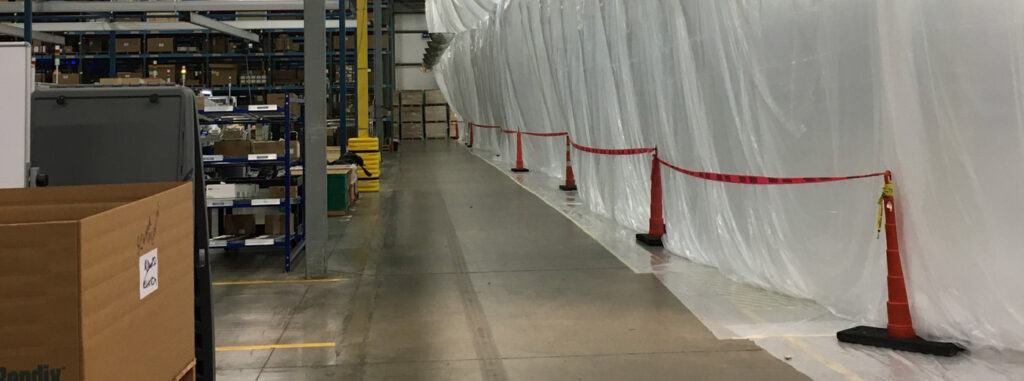
Paperwork and Industrial Paint Projects
Is a Permit Necessary for Industrial Painting?
In general, it’s not necessary to secure permits prior to your industrial painting job. This is only called for in rare cases – especially for bonded jobs and government clients. Usually, someone in your organization will already know the requirements your project needs to meet.
Most commercial facilities can paint at will without any concerns.
What About Insurance?
In most cases, you don’t need to worry about holding any type of insurance. If you aren’t sure, you should discuss the details with your insurance provider before you start on your project.
Except in rare circumstances, it’s the contractor’s duty to be up to date on insurance covering work at client sites, property damage, and injuries. Be sure to get evidence that a contractor holds active, valid policies before hiring.
Setting Up for Contractor Communication and Access
In industrial painting, it is vital to have open lines of communication on both sides, and regular updates from the contractor.
Designating a project manager within your team goes a long way toward maintaining clarity.
Most large enterprises have defined this role somewhere in the org chart. Smaller companies and those who have not worked with industrial painters before should take time to clarify roles and choose a project owner as the main point of contact.
In the weeks before the contractor arrives on-site, the client PM has some work to do:
Move Equipment as Necessary
If certain equipment is in the way of surfaces to be painted, it is best if you move those items. Contractors cannot insure liability for all equipment and typically don’t have the specialized knowledge to move key equipment. When the contractor arrives, items in the project area that won’t be painted are covered up. Inaccessible surfaces will not be treated.
Make Announcements to Affected Personnel
Your contractor will provide estimates on timeframe. You can use these to anticipate equipment downtime and other issues. Be sure that members of your team understand how a paint project may affect their day-to-day duties and how their work routine should change, if at all.
You may also need to plan follow-up announcements with your team members during certain steps in the process or if a project takes longer than planned. This is all covered in greater detail in Chapter 4, “Handling the Painting Project in Progress and Possible Downtime.
Provide Facility Access
Most painting projects are scheduled throughout the working day. For smaller projects and very sensitive work environments, however, work might take place when employees are not on site. Regardless of timing, it’s important to establish access to utilities and amenities like bathrooms.
Contractors typically ask their clients to clarify the following before work begins:
- May contract personnel use on-site bathrooms?
- May contract personnel use on-site dumpsters?
- Is the site a smoking or non-smoking facility?
- What type of electricity is used in the facility?
- Is there access to compressed air?
- How can contractors connect to on-site water?
Many industrial painting equipment requires access to compressed air. Facilities may lack access to this, meaning contractors must provide their own air compressors on a per-diem basis.
It often saves time and money to allow contractor hookups to on-site water for power-washing the exterior surfaces to be painted. This eliminates the need for a separate water tanker.
Resolve Any Environmental Hazards
Sometimes, there are environmental hazards like mold, asbestos, and lead paint that should be addressed before a painting project begins. These factors can endanger the health and safety of people in the area, and make certain types of painting processes impossible.
Very few industrial painting contractors have the expertise to manage remediation on their own. At Preferred, we can check for lead and asbestos and provide outsourced expertise on these matters for clients who need it.
Be aware that, depending on the situation, hazard resolution can add weeks to your project timeline.
Control Hazardous Equipment and Energy Sources
Last, but certainly not least, be sure to follow OSHA procedures to lockout-tagout (LOTO) any dangerous equipment to prevent it accidentally turning on during the painting process. This protects contractors’ safety and your equipment from the hazards of a preventable emergency.
Get Tools and Tips From the Experts on Painting Estimates
Industrial Painting Planning: Right Way, Wrong Way
Jim rushes the process, getting contractors on the phone right away. When they arrive on-site, they find lots of areas blocked off by equipment that hasn’t been moved. Employees wander through the work area, leading to delays. A patch of mold is discovered, now Jim has to contract a remediation service and the painting project timeline has moved forward by weeks.
Rob takes things one step at a time, starting by making sure everybody on the worksite knows what’s going on. Clear communication keeps distractions to a minimum and ensures the contractor has access to needed facilities, saving lots of time and money.
Remember:
- It’s your responsibility to move and secure key equipment and to make areas accessible.
- Communication is essential: Keep your team members and your contractor in the loop.
- Recognize and eliminate environmental hazards before a project starts to save time.
Part 3
What Is Being Painted?
Clear priorities early in the project will help you save money and select the right contractor for the job at hand.
Your budget and operational requirements dictate what should get painted and when. Whether you’re painting for aesthetics or performance, some areas are going to be more important than others.
A full inspection of your facility is an essential first step to planning out your project.
Luckily, there are some guidelines to help you recognize urgent priorities.
We’ve broken things down here using the Rule of Threes:
- Three things you should always paint first when given the option.
- Three things you should paint whenever budget and time allow it.
- Three things you should never paint.
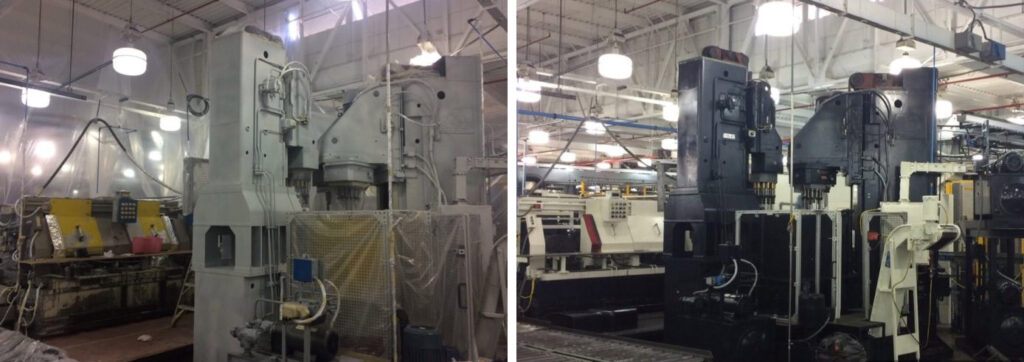
The Most Vital Things to Paint in Any Industrial Painting Project
1. Start With Rust
Rust on steel components is a sure sign that painting is needed as soon as possible. Painting can extend the life of many pieces of equipment, especially tanks. Untreated rust can lead to serious business disruption and major replacement costs in the future.
2. Examine Equipment Exposed to Steam or Acid
Whenever you have a new process that involves steam or acid, keep a close eye on nearby surfaces – particularly the ceiling. Often, companies will bring anodizing in-house and discover that their anodizing lines produce more wear than anticipated.
3. Refresh Your Walls and Ceilings
Your walls make up the first impression of customers, new employees, executives, and others who contribute to your success. Once anything that might cause equipment damage is taken care of, walls and ceilings should be the next thing on your list.
What’s the easiest way to sort out essential painting tasks from non-vital ones? It’s simple.
Always ask yourself: “Do I have any structures at risk of rusting? Is there potential for rust in the future?”
Whenever the answer is yes, you’ve uncovered a leading priority for your paint project.
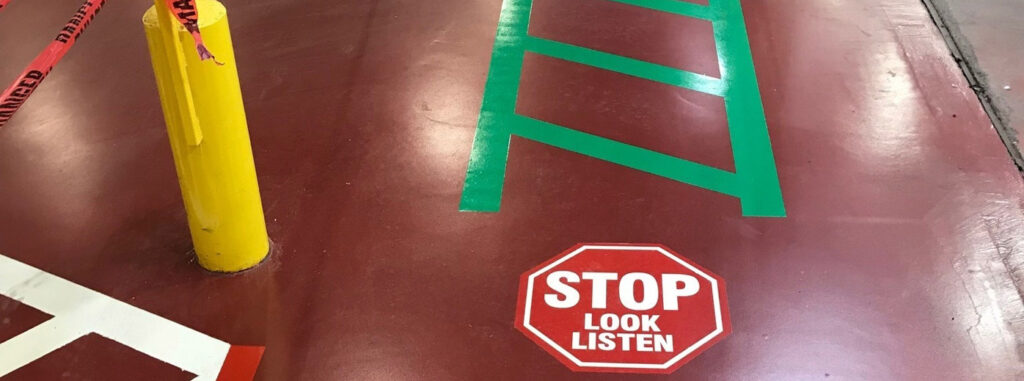
Other Elements to Incorporate into Your Plan
1. Address Possible Customer Concerns
If they feel your facility isn’t up to their standards, customers will balk. When customers have limited knowledge about manufacturing, their assessment usually relies on aesthetics. This is why ceilings and walls along customer tour routes should always be given special attention.
2. Consider Updating Safety Painting
Firefighters appreciate industrial facilities with color-coded pipes – and in an emergency, this can save precious moments. Other areas to look at include safety painting at crosswalks, high traffic areas, and especially hazardous parts of your plant.
3. Don’t Forget About Regulatory Compliance
Regulatory compliance remains a major cost for many manufacturers. Make sure compliance experts are included in your planning so any requirements can be incorporated. In some industries, even chipped paint can lead to sanctions.
What Items Should Never Be Painted?
1. Stainless Steel
Stainless steel is meant to be maintenance-free. It is designed not to be painted, though, it does happen when need requires, such as waterproofing and coating. But it is rare, and not an initial measure. If you notice corrosion or rust on an appliance that’s intended to be stainless steel, you have a whole different problem on your hands – take it up with your OEM!
2. Galvanized Metal
Galvanized steel and iron contain a protective zinc coating that prevents the development of rust. Thanks to the coating, galvanized metal resists adhesion of most paints. While painting it is sometimes possible, it is not necessary. On top of that, it adds a lot of cost and complexity.
3. Anything Not Intended to Be Painted
When in doubt, it is always best to ask the experts – whether your equipment manufacturer or painting vendor. As with galvanized metal, there are many items that could be painted, but it is still a bad idea. And, of course, there are cases where painting could cause equipment failure.
Is There a Right Time of Year for Painting?
Generally speaking, the best time to schedule your painting project is when it will meet your needs. If you have a seasonal schedule that dictates your workforce or how your facilities are used, then picking a time frame that will produce minimal disruption is a good idea.
In all other situations, it depends on the nature of your project.
Indoor Projects
Indoor projects can be handled at any time, regardless of the weather or temperature outside. Be aware, though, that some treatments and paints require sustained indoor temperatures within a certain range, so they will adhere and set properly. Be sure to consult with your contractor about monitoring your indoor climate.
Outdoor Projects
Outside projects are “weather permitting”, temperate or warm weather is best. Exterior painting work can be delayed by rain, snow, and wind storms: There’s no point in applying new paint unless you can count on three days without rain!
Many industrial clients plan their paint projects around the holiday season, when there are fewer employees on site. While this can be a great idea, it is also a very popular strategy, so be sure to book your project early so you have the time frame you want.
If you need advice on how to best prioritize your painting needs, then get a free painting consultation from us.
Ask the Right Questions About Your Project
What to Paint: Right Way, Wrong Way
Jim decides he wants to paint “everything.” The work is slow going, since no clear priorities are established. Some equipment succumbs to rust and acid damage because it wasn’t treated right away. Jim’s project runs long into his firm’s busy season, adding hundreds of hours.
Rob works with his safety and regulatory compliance teams to set clear expectations. By noting areas of rust and steel loss, he gets vital equipment treated fast, saving thousands. Since he is in the slow season, there’s time to repaint customer tour routes. This helps the company close a big contract!
Remember:
- Always start painting with areas where you’re losing steel or might in the future.
- Set clear expectations that help you protect your most valuable equipment first.
- Scheduling early lets you launch your project in a slow season, saving you time.
Part 4
Selecting Quality, Color, and Type of Paint
Good news: You don’t have to worry about selecting the right materials for your project!
Choosing the right paint for the project should be left to your contractor – they need to match the paint used to the equipment, life-cycle, and your budget. In the long run, there are too many factors involved for clients to make these selections.
That said, you’re not a passive participant in the process, either! There are questions you can ask and knowledge you can take with you into the process.
Let’s cover the points that you should know as an informed client.
Paint Quality and Performance
Although some brands compete on price and others don’t, paints intended for the same jobs don’t differ by much. There is no uniform, universal scale that determines paint quality: Again, this comes down, in part, to an experienced contractor’s judgment on which option is best.
However, there are tests to ensure quality in high-performance paint applications:
TABER Abrasion Test
Also known as abrader testing, TABER is a form of accelerated wear testing that gives a sense how long a paint job will last under working conditions. It was introduced in the 1930s and uses specialized equipment to apply rub-wear abrasion action on a painted material sample. ISO 7784 standards can be used to determine whether paints and varnishes are sufficiently resistant.
Salt Spray Test
The salt spray test is one of the most common paint performance tests. You may also see it referred to as the salt fog test. It measures paint and surface coating quality based on observed corrosion resistance. Resistance is quantified by the number of hours the surface can stand up to application of a salt spray. International standards suggest 96 hours as a good baseline.
Chemical Test
The physical and chemical properties of individual paints can tell you a great deal about how well they will stand the test of time. A wide variety of chemical tests are available. Which ones are appropriate will vary greatly based on your working conditions. The basic purpose of each is to ensure that paint and coatings won’t break down through environmental exposure.
Pull Test
Pull testing is used to ensure proper adhesion for epoxy coatings commonly used on concrete floors. This helps you estimate your floor’s capacity to remain undamaged under different weight and movement conditions. For suitable longevity, the epoxy coating needs to have a tensile strength greater than what is required by your working environment.
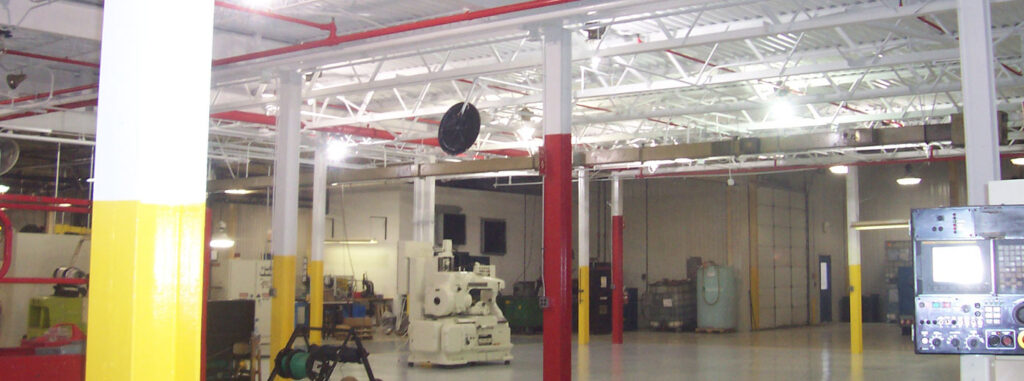
Paint Cost and Volume Discounts
Many clients ask us if they could potentially save money on their projects by working on surface preparation or other matters independently. The answer is a resounding “No!”
There are two main reasons for this:
Prepping a Surface Causes More Problems Than It Solves
It’s always best when surface prep is managed by the same team that will do the painting.
Each contractor has best practices they develop through experience. Techniques for approaching each job are intended to add longevity and beauty to your project. It starts at the very beginning, with professional surface preparation.
When clients try to set up the painting project independently, the work they do is removed and redone completely once contractors reach the scene, regardless of the client’s efforts. That means added time and cost that you can easily avoid.
Contractor Paint Costs Are Lower than Retail Prices
Although prices don’t vary much by brand, paints intended for certain industrial applications can be expensive. Luckily, industrial painting companies like Preferred, Inc. – Fort Wayne can get large supplies of these paints at a discount due to the volume of work we process every year.
Ultimately, using Preferred, Inc. – Fort Wayne saves you thousands of dollars on materials. This alone is much more than you could expect to save by doing any preparation or other work in advance.
Of course, many established contractors also get discounts. When evaluating a contractor, ask them about their material costs relative to the retail price. The best contractors do not mark up the cost of paints – instead, they pass on their savings directly to you.
The Most Important Rule for Picking the Right Paint
There is one question you can always ask: “Is this the right paint for the job at hand? If so, why?”
At Preferred, we use Sherwin Williams and PPG paints for the majority of our work.
Each contractor may have different advice on types or brands based on specific applications. Everything – even whether a ceiling should be painted white or black – is job-specific. Still, you can tell when a contractor is giving full, honest, well-considered answers.
If you want expert advice on the right type of paint to use on your next industrial paint project, then get a free paint consultation from us.
Get Tools and Tips From the Experts on Painting Estimates
Color, Quantity and Type of Paint: Right Way, Wrong Way
Jim wrangles some junior procurement agents to buy gallons of paint. The markup is substantial, and now the budget for the work of the actual painting is reduced. Jim insists on power-washing the walls. The result looks good to him, but it ultimately has to be redone by his contractor, adding his own time spent to the project’s already inflated budget.
Rob reads up on the type of testing that might be necessary for his project, but avoids doing any purchasing or surface preparation himself. When the time comes to interview contractors, he knows his stuff.
Remember:
- The selection of surface treatment and paint is complicated – it’s always job-specific.
- Never try to prepare a wall surface yourself – your contractor has a Preferred way of doing it.
- A contractor should always be able to explain and justify all material selections.
Part 5
Budgeting for Your Painting Project
Industrial paint projects can run anywhere from $2,000 to $1 million.
With this in mind, facilities managers usually seek out bids from prospective contractors early in the process – starting with estimates that encompass everything they might want done, then reducing the scope of the job until it meets their budgetary needs.
Painting usually must be approved by high-level decision-makers. They want to understand the business case behind the project before they will come on board.
Should You Wait to Start Painting Until You Have Your Full Budget?
It’s typically best to get started with a job as soon as possible. The sooner you get started, the sooner you can finish – and most teams find it much easier to approve half their project budget in six months rather than all of it in twelve.
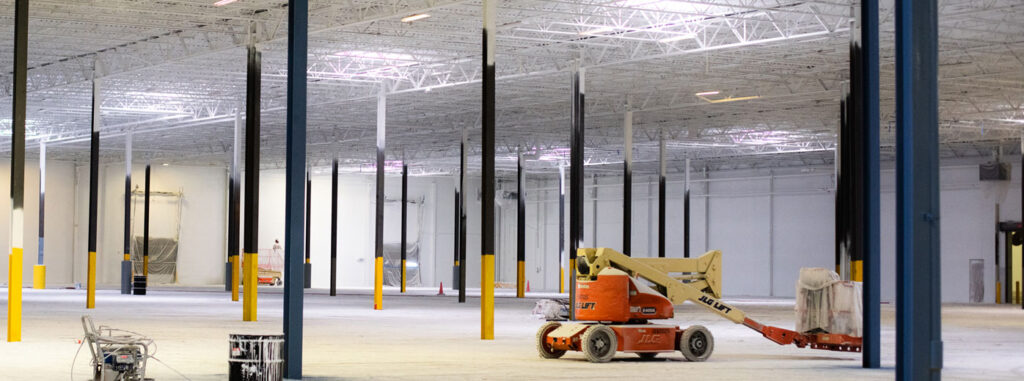
Can Clients Estimate Total Cost? If So, How?
Many clients end up spending a lot of time on “fact-finding missions” that go nowhere.
There are many different factors that influence final cost, including:
- Square footage of your facility.
- Surface preparations required.
- The type of paints to be used.
- Number of coats to be applied.
- Equipment and personnel needed.
- Utilities like generators and water.
- Timeframe (if deadlines are a factor).
- Unforeseen issues during the project.
- Amount of congestion in the area.
- What equipment must be protected.
Needless to say, this is a lot to take in. Accurately estimating a large industrial painting project takes many years of experience. Even an expert project manager has to carefully consider all the variables and the ways the project and your business might interact.
With that in mind, the best thing you can do to protect your budget is develop a comprehensive Statement of Work. Your SOW is the guideline all prospective contractors start out with. The more detailed and accurate it is, the better it is for both your peace of mind and the bottom line.
Our guide includes a Statement of Work template that can help you get this process off on the right foot. For more insights, look to Chapter 7: “How to Hire a Qualified Painting Contractor”, and Chapter 8: “What to Include in Your Contract.”
What Can Business Owners Do to Save Money?
Aside from a great Statement of Work, there are two things you can start on right away to make your project more efficient.
Make Areas to Be Painted Highly Available
The easier it is for the contractor to get in, out, and around the area to be painted, the sooner the work will be done and the easier it is to avoid wasting resources. This might require you to think about the best ways to retool certain workflows, but it is worth it. When all is said and done, thousands might be saved. That can make a big difference in how much you can get done.
Make Facilities Available if Possible
It’s almost always better to give your contractor access to a water line rather than pay separate per diem fees for a water tanker. You should only avoid doing this if there are specific reasons to do so based on water costs or availability.
Another area where money can (sometimes) be saved is with an air compressor. Make sure your facility can support the CFM requirements your contractor needs. This can save you air compressor charges.
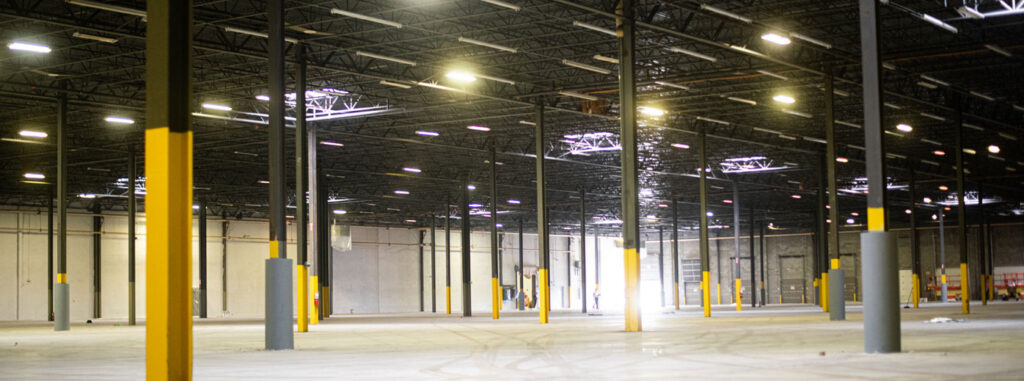
How Much Time Can You Expect Your Project to Take?
Although timeframes vary, the experience of your contractor and total square footage to be painted give you some good insights. An effective contractor can usually manage 10,000 square feet in a weekend. For 1 million square feet, expect about a year.
Outside of square footage, the two biggest factors affecting timeline are:
Congestion: How difficult it is for contractors to access the area consistently to work.
Surface Preparation: How bad surfaces currently are and what needs to be applied.
Final Budget Considerations
When it comes to choosing a contractor, the power is in your hands. Always ask what products are being used, how the surface will be prepared, and how products are being applied. Even the best products will not perform well if cheap, low quality applicators are used.
In any collection of bids, estimates should be similar. Be cautious of high and low bidders. (This can indicate possible corner cutting or poor material usage)
If you’d like to get a free quote from an experienced industrial paint contractor, then click here to get in touch with us.
Ask the Right Questions About Your Project
Commercial Paint Project Budgeting: Right Way, Wrong Way
Jim finds himself putting his painting project off for months as he tries to get his boss to sign off on the budget. Since no part of the work gets started, he misses deadline after deadline. Instead of spending time on a detailed Statement of Work, he picks the lowest bidder.
Rob can’t get the full budget for his project right away, but goes ahead with what he can do. By developing a detailed SOW, he has his choice of the best contractors for the job. He trims more than three months off his timeline by ensuring areas to be painted are easy to access.
Remember:
- Depending on needs, materials, and square footage, projects run $2,000 to $1 million.
- It’s essential to have a detailed Statement of Work to solicit fair bids from contractors.
- If your budget is tight, define part of a project to do right now and do the rest later.
- Once a project starts, the best way to save money is to make areas highly accessible.
Part 6
Surface Preparation & Cleaning Before Painting
A wide range of surface preparation processes come together in a project depending on the surfaces to be painted. Many require specialized equipment and they must be handled carefully to get the best results.
The main purpose of preparation is to remove old paint and ensure a uniform surface. It can be a long process and is a major cost driver in a project. That said, clients should avoid the temptation to do any surface preparation on their own. Even if the right processes are applied to the right surfaces, it’s easy to overlook details that can come back to haunt you. At Preferred, we’ve often had to redo surface prep processes after clients try to chip in. This can add weeks to your timeline, not to mention costs. The bottom line: Don’t do it!
Focus your energy on verifying you lockout-tagout (LOTO) all appropriate equipment so it doesn’t turn on during work.
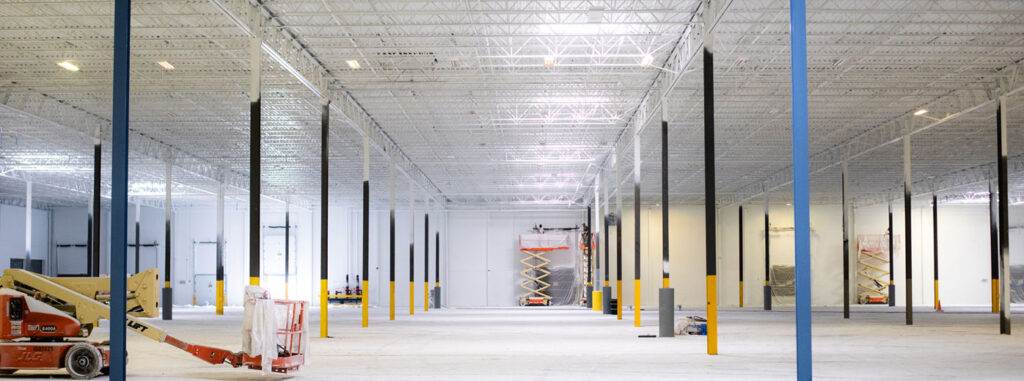
What Surface Preparations Are Used Before Painting?
The surfaces being treated and the materials being applied dictate preparation needs. Professional standards include many different types of preparation. Each one has its own equipment, costs, and use cases – some projects might use only a few or just one type of preparation.
These steps are the foundation that ensure your paint job will look great and last longer.
The major techniques to look for include the following:
1. Steam and High Pressure Cleaning
Pressure washing is used to prepare exterior surfaces before painting. The same equipment often has steam settings – these are used to prepare machine surfaces. Dry vapor (a high temperature, low moisture vapor) is used to clean and sanitize surfaces while eliminating build-up that can affect performance.
2. Solvent Degreasing
Solvent degreasing prepares metal parts for painting. It’s also used to support other operations, like electroplating. A specialized machine turns soap into a foam that is precisely sprayed on and then rinsed off. It can be used on interior walls and machinery.
3. Water Blasting
Water blasting uses high-pressure water to clean surfaces. It is more powerful than pressure cleaning and removes a thin layer of the original surface material along with dirt and grime. This can ensure that the surface is more uniform when it is time to apply materials.
It is most frequently used to remove loose paint from exterior siding, tanks, and blocks.
4. Soda Blasting
Soda blasting exposes a surface to sodium bicarbonate particles propelled with compressed air. The result is a very mild abrasive cleaning. Because the particles are so absorbent, they can often remove stubborn contaminants. Soda blasting is gentle enough for plastics, chrome, and glass.
A high-pressure wand is used to carefully direct the flow and effect detail cleaning. This is the only option for more sensitive equipment and machines, but it does take longer. If there’s any concern about protecting a particular piece of equipment, this is the way to go.
5. Sand Blasting
On the other end of the scale, sand blasting is the most abrasive form of surface preparation. It can be used on walls and ceilings either inside or outside. It is great at removing paint, especially on concrete surfaces. It can also be used on tanks.
6. Dry Ice Blasting
Dry ice is solid carbon dioxide. It is used in many different products, especially to keep produce cool during transportation. That said, it can be dangerous to work with, so your employees should steer clear. It is mainly used on ceilings and machines to remove loose paint.
How to Know You’re Getting the Right Surface Preparation for the Job
If the wrong preparation is used for any surface, the damage can be severe. In the worst scenarios, your equipment might require repair or replacement.
The information above will serve as a useful guideline, but it’s still important to ask questions of your contractor and ensure they’ve thought through the process.
Many forms of surface prep are potentially harmful to people, equipment, and other assets. In general, contractors should always choose the least abrasive surface prep that can get a job done in a reasonable amount of time. The surroundings should also be considered.
Always ask the following questions:
- “Could this harm any of our equipment?”
- “Is it bad for our employees in the area?”
- “How are you going to clean this up?”
Even when a surface prep isn’t very hazardous in and of itself, it’s important to be alert to the complications that can arise during cleanup. No matter how long preparation takes, cleanup might leave an area inaccessible for a period of time.
Contractors should be careful to apply the right media and aggregate for the situation. No option is perfect, and there’s bound to be some inconveniences – but the contractor should be able to explain the reasoning behind any selection.
Get Tools and Tips From the Experts on Painting Estimates
Surface Preparation: Right Way, Wrong Way
Jim looks for ways to perform surface preparation in-house. It costs him dearly to get the equipment and, thanks to lack of experience, a lot of treated surfaces get damaged. Since no time was spent verifying that dangerous equipment is secured, Jim narrowly avoids a big accident.
Rob works with the teams on his factory floor to be sure lockout-tagout (LOTO) has been done for all hazardous equipment. He knows which questions to ask his contractor and makes sure he understands the communication and cleanup procedures that will keep things safe.
Remember:
- Although you can’t prep surfaces yourself, you can verify work your contractor does.
- Asking the right questions will ensure your project is as safe and efficient as it can be.
- It’s your responsibility to lockout-tagout (LOTO) equipment that could be hazardous.
Part 7
Handling the Painting Project in Progress and Possible Downtime
Every industrial painting project involves some downtime. It’s usually best to “bite the bullet” and let this play out naturally, reduce foot traffic in the area and removing barriers to entry in the area to be painted.
The more you can control congestion around the project site, the easier it is for the contractors to perform prep and painting quickly. The savings in time can make a significant difference to your final expenses.
That said, there are some ways to minimize downtime and maximize efficiency:
- Safety: Preventing reportable safety incidents among your personnel during painting.
- Communication: Staying on the same page with your contractor throughout a project.
What Safety Precautions Are Necessary During a Project?
When it comes to safety, your contractor will do the lion’s share of the work.
They bring personal protective equipment for their team members, manage safety issues around all equipment and utilities as it relates to them, and give you information you need to know about hazards that could affect your personnel.
On your end, observe these best practices:
Plan Out Areas of Limited Access
Early in the process, your contractor should have a fair idea what needs to be done and in what order. Using this information, do what you can to limit employee access, redistribute workloads, and reduce foot traffic through areas as they become the active focus of the project.
Make Announcements to Employees
At the outset of any project, make sure everyone knows what expectations apply to them. If members of your team don’t know what’s going on, honest mistakes are much more likely. You should occasionally update employees as progress warrants.
Update Personal Safety Guidelines
It might be inevitable that work must continue around an area where painting is being done. When this happens, call in your safety and compliance team leaders to ensure all precautions are enforced – including additional personal protective equipment where needed.
Maintaining Good Communication During Your Project
Communication between the client and contractor is essential to success. The catch is, it’s up to the client to set the standard. If you don’t show an interest in regular communication, contractors may assume you expect them to “just get it done” with a minimum of interaction.
The best industrial painting firms can, indeed, be left largely on their own to do the work.
Still, it’s a good idea to maintain regular communication – especially if you haven’t worked with a particular company before. Not only does this help prevent oversights, but it puts unscrupulous characters on notice that you are paying attention.
Here’s how you should set up communication to maximize effectiveness:
Daily Check-Ins
A morning check-in is a good idea since it gives you the information you need for any updates to your employees. It also keeps the lines of communication open, so complications or problems are more likely to be addressed up front. This is best for both you and your contractor.
Bi-Monthly Progress Reports
It’s often hard to see the forest for the trees, so a major update every two weeks helps measure project progress more accurately. Contractors should have clear, concise answers about what they’ve achieved, what’s up next, and what issues – if any – might be relevant.
“Surprise” Inspections
It never hurts to drop in for a quick visit now and then. Even when everybody has the best of intentions, days drag on and oversights can happen. When it is obvious that you’re invested and aware of the process, contract personnel are much more likely to succeed.
Red Flags to Be Aware of During Any Painting Project
Good communication from the very start helps to ensure all issues are addressed. In a well-run project, there should be few surprises. Still, you should keep an eye out.
Problems during a project usually take one of three forms:
- Aesthetics: Progress is made, but “completed” areas don’t look as good as they should.
- Time frame: Progress is too slow, with the blame going to equipment or staffing issues.
- Quality: Machine operators notice damage or equipment malfunctions in finished areas.
Whenever these issues present themselves, it’s essential they get resolved right away – don’t wait until everything else is done. Additional time, equipment usage, or other problems caused by contractor oversight should be covered by your contract.
Operating Temperatures Matter for Paint
On a final note, be sure your facilities manager knows the operating conditions your paints need.
While temperature can’t be helped at some facilities, most plants have granular control over working temperatures. Each type of paint dries best within a specific temperature range and under relatively low humidity.
Daily updates from your contractor should include all the information you need on temperatures – and when maintaining a given temperature is no longer necessary.
If you need help determining the best way to clean and prepare surfaces for painting, then contact us for a free painting consultation.
Ask the Right Questions About Your Project
Project in Progress: Right Way, Wrong Way
Jim forgets to let his employees know about the painting in progress until the day before. Since there’s no time to make areas accessible for painting, he ends up having to make costly choices between productivity or keeping his project on track. That disrupts work for everyone.
Rob makes communication a priority. With regular updates from his contractor, he is able to keep his employees busy even when it’s crucial they stay out of certain areas during painting. He makes time to inspect the contractor’s work, so any issues get addressed early.
Remember:
- Check-ins, progress reports, and snap inspections keep everyone on the same page.
- It’s up to you to keep your team informed so they can cooperate with your project.
- If you’re not satisfied with your contractor’s performance, bring it up right away.
Part 8
How to Hire a Qualified Painting Contractor
An industrial painting project keeps your facilities looking and functioning their best. They not only help boost the morale of employees, customers, and clients, but even support workplace safety goals. Likewise, a botched project can undermine all your hard work.
Vetting industrial painting contractors puts facilities managers in a tough spot. Industrial painting projects can’t go to just anyone who can hold a paint roller. Yet, smaller, less experienced firms are often attracted to these jobs based on their higher profit potential.
Contractors will do everything in their power to persuade you that they’re qualified for the job. They may even offer remarkable prices based on a lack of experience planning such a project.
However, the upfront savings (if any) will quickly be offset by delays and quality issues.
The Internet offers unprecedented power for any company to present itself as the solution for any situation. That means the hiring process needs to be more thorough than ever before.
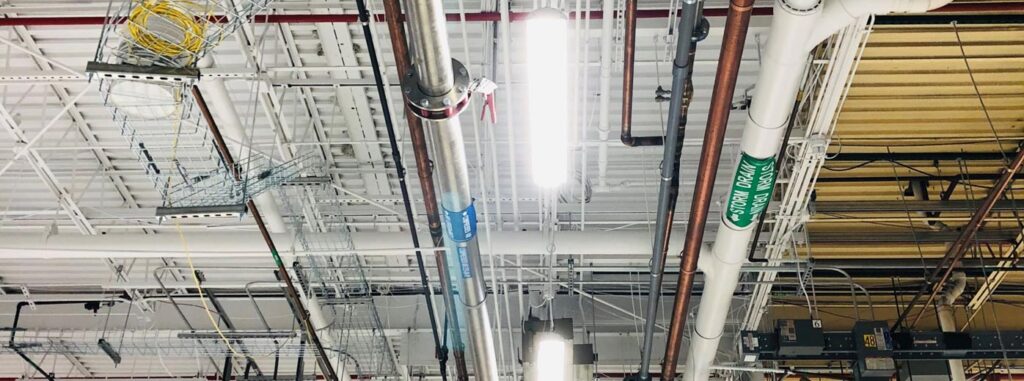
Your Statement of Work is Your Most Powerful Asset
Hiring for industrial painting should start early so you can design a Statement of Work in-house.
A Statement of Work is the ultimate tool for avoiding contractors who can’t meet your standards.
When you’re able to lay out a complete SOW in writing, you establish clear standards – and, to an extent, reduce liability by ensuring any bidder must assert their willingness and ability to perform according to those requirements.
An industrial painting SOW should include:
- The specific areas of your facility to be painted, in as much detail as possible.
- Special considerations, such as caulking and priming, throughout the project.
- Restrictions needed to prevent business disruption, such as night-only work.
- The ultimate deadline of the project, as well as specific milestones to be met.
Five Things to Check During Contractor Selection
It’s a good idea to solicit estimates from at least 2-3 firms to ensure you have a broad range of potential vendors. Especially low and especially high bids should be accorded extra scrutiny.
Vendors serious about a job should be willing and able to submit all the documentation you will need to evaluate their bid – and they should do it promptly. This demonstrates professionalism, and reduces the time you’ll need to spend hunting online for information.
That said, be sure to look closely at these areas:
Recent Clients
A contractor’s typical client is a good barometer of the type of work they do and the standards they are able to meet. Ideally, they should be able to point to recent projects similar to your own. It’s also usually a good sign when a contractor has performed military projects. These involve strict deadlines, as well as health and safety compliance.
Team Composition
It takes more than painters and equipment to execute a large industrial painting job. When a business is ready to tackle a big project, it has the right support personnel to deliver excellence.
Be sure your would-be contractor has these professionals on the payroll:
- A safety coordinator with active certifications from OSHA and CERT.
- Sourcing, logistics, fleet management, and DOT compliance personnel.
- A quality control supervisor with active SSPC and NACE certification.
- A “point-of-contact” project manager experienced in project estimating.
- Appropriate accounting, administrative, and customer service personnel.
Demanding Projects
A contractor’s ability to service complex, difficult projects is a reflection of skill. Even if your worksite isn’t especially challenging, it’s reassuring when a bidder lists sophisticated, highly visible work like facility exteriors, and storage tanks, for example.
Safety Training
Safety should be a priority on any project site. It’s up to the contractor to bring the right safety expertise to bear every time. Contractors should furnish documentation on key certifications.
The following certs offer a good foundation for safety performance:
- OSHA 30-Hour for General Industry or Construction.
- Fall Protection Training.
- Confined Space Training.
- Respirator Training.
- Hazcom Training.
- Scaffold Training.
- Lead Training.
References
If you’re satisfied by the fundamentals, you can look at references. Online reviews are an okay place to start, but they can be manipulated or manufactured, so take them with a grain of salt.
If you encounter unfavorable reviews, check to see if the company has responded directly to the customer and resolved the issue. Negative feedback without a response is a red flag. When interviewing a contractor, you can draw on posted feedback to ask them the tough questions.
Ideally, contractors will put you in direct contact with at least 5-10 satisfied clients.
Hiring a Qualified Contractor: Right Way, Wrong Way
Jim believes in hiring people he “feels good” about. He hits it off with a contractor – who happens to be the low bidder – without checking references or safety credentials. The contractor doesn’t have the right expertise, so the “cheap” option ends up taking four extra months.
Rob checks out potential contractors from top to bottom. After ruling out the low bidders for not having the right experience, he grills a mid-sized contractor team about past projects and some negative online feedback. Their answers and other qualifications impress him, so he picks them.
Remember:
- Under-qualified contractors will fight hard to convince you they can handle your job.
- Your Statement of Work is the most useful tool for weeding out unqualified bidders.
- References, past projects, training, and client feedback should all inform your choice.
Get Tools and Tips From the Experts on Painting Estimates
Part 9
What to Include in Your Contract
NOTE: Any industrial painting project is a major undertaking with plenty of moving parts. We aren’t lawyers, and nothing you read here should be construed as legal advice. Direct all legal questions to qualified counsel experienced in commercial law.
Do You Need Your Own Contract for Industrial Painting?
The majority of industrial painting contractors will have a boilerplate agreement you can choose to sign to get work underway.
This covers all the services the contractor in question typically provides and includes a few minor additions or tweaks to conform to your expectations.
Of course, none of the language specifically pertains to you.
Does that matter? It depends on who you ask!
Boilerplate legal language is a fact of life. In fact, it would be pretty strange if a contractor didn’t have language worked out for everything they do on a regular basis.
Although you’ll rarely need to write a contract from scratch, it’s a good idea to have your legal team thoroughly vet an agreement before executing it.
If a contractor isn’t willing to sign a contract your team developed, it may mean they don’t stand by their work. It’s always best to learn that sooner, not later.
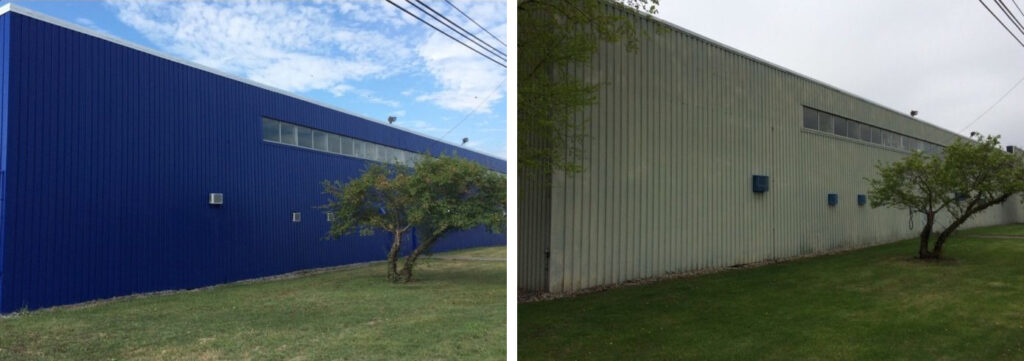
Should You Negotiate with Contractors?
In almost all cases, the answer is no.
Experienced contractors usually have a fixed price for services based on project specifications. Contractors who are eager to negotiate may be signaling an intention to cut corners on your job.
Once the project specs are clear, there are two ways for unscrupulous contractors to save money:
- Materials: Using cheaper paints, surface preparation methods, and applicators.
- Time: Rushing to the next job, often by applying just one coat instead of two.
If you are pleased with the caliber of work you see in a contractor’s portfolio, the best thing to do is avoid haggling. This demonstrates respect and puts your relationship on a stronger foundation.
That doesn’t mean there’s no way to save money at all, however.
Once you have a written estimate for the complete job, you can make the right decision for your budget. Instead of trying to cut service costs, consider breaking down your project – half now and half later. This makes things more manageable and lets you build momentum, too.
The rule of thumb is this: Instead of adjusting time or cost, adjust scope.
What Kind of Guarantee Should You Expect?
A guarantee helps ensure that things are done right the first time.
Dishonest contractors often won’t provide a strong guarantee. They are hoping that they will be well onto the next job – and the job after that – before you realize you’ve been short-changed.
You shouldn’t settle for anything less than a 1-year guarantee. Even so, it’s vital to have your legal team look things over and identify loopholes that might be used to avoid satisfying you.
A guarantee that looks like Swiss cheese is as good as not having one at all.
Standard Contract Issues in Industrial Painting
Time frame
A contractor has the right to attach a time limit to a given proposal. Proposals are a snapshot of the situation at the worksite at a particular time, and assets need to be held in reserve while waiting for your decision – so, a proposal is usually invalid after ten days.
Non-Payment
As with anyone else, contractors rely on their clients being straightforward with payment. Contracts usually define steps to be taken if payment is delinquent, leaving the client to pay all collection expenses and legal fees.
Unforeseen Circumstances
A contractor’s word is his bond, but there are protections to keep the company from getting roped in to a dire situation. For example, if a contractor discovers mold that needs to be resolved before painting, additional work – and fees – will result.
An Important Word on Payment Terms
If a contractor asks for all money up front, run the other way.
There are many different payment terms that upstanding contractors might use. These include net 30, net 60, net 90, and anything from zero down to 50% down. No matter what the specific terms are, however, the contractor should never collect all the money until all the work is done.
At Preferred, Inc. – Fort Wayne, we generally use a 50% down and 50% on completion approach.
This helps clients more easily predict what investment they’ll be expected to make and when. That adds greater stability to the business on both sides, avoiding confusion and complications.
What About Insurance?
The contractor is responsible for holding insurance for all matters that might arise during the job, including injuries to their personnel and property damage. Requirements vary by jurisdiction, so have your legal and safety team ensure all insurance is valid and up to date. If you are unsure about your own insurance obligations, consult with your insurer.
Ask the Right Questions About Your Project
Project Contract: Right Way, Wrong Way
Jim starts off by negotiating hard and drives off two well-qualified firms. When he comes down to the contractor “willing” to cut prices for him, he doesn’t check in with his legal team. He ends up agreeing to a guarantee that’s all but useless when the contractor disappears.
Rob has his legal team carefully review each bidder’s contract terms. When he interviews bidders, he doesn’t haggle, showing respect for their work. Ultimately, he picks a firm that offers a strong guarantee that truly protects his investment in the work.
Remember:
- Most established contractors have boilerplate contracts covering their usual work.
- Contractors who aren’t willing to sign your own contract may be up to something.
- You should always have your legal team scrutinize all contracts and guarantees.
Part 10
Auditing the Final Paint Project
Congratulations! The hard work is done. It’s almost time to enjoy the fruits of that labor.
As the work draws to a close, there’s usually a temptation to sit back and let things coast to the finish line – especially if you haven’t had any delays or other hang-ups so far.
Remember, it’s vital to see things through to the end, both for you and your contractor!
In the last few days of painting, these three steps will safeguard your investment:
1. Keep Up With Daily Reports
If communication with your contractor has been strong, the end of the project is a terrible time to let it lapse. Maintaining the flow of daily reports will help make sure nobody is tempted to overlook those all-important last steps. It’s not over ‘til it’s over.
2. Perform Visual Inspections
Spend a few hours checking work in detail. If quality is uneven – some areas look shabby compared to others, say – it’s better to find that out now. Once the team has wrapped things up and moved equipment out, it could take weeks to get them back on-site.
Visual inspections can be performed during the work as well, not just after. A surprise “spot inspection” helps establish that contractors are using the high-quality materials they promised in their proposal, not the cheap stuff.
3. Test and Verify the Work
If you haven’t seen problems throughout the project, testing every inch is probably overkill. Still, it’s a good idea to use a MIL gauge to check the last few pieces of work. MIL gauges measure the thickness of coatings once they’ve been applied to a surface.
A MIL gauge is cheap and easy to use, requiring no special training. The only catch is that you must take measurements soon after a coat is applied, before it has the chance to start drying. Timing is crucial, so use what you learn in those daily reports to your advantage.
A MIL gauge is an incredible tool for keeping everyone honest, since it uncovers one of the most common ways to cut corners: Applying just one coat of paint instead of two. This is much more likely as the end of a project approaches.
As the project winds down, the contractor should ask you to sign for final approval.
Use our Paint Project Audit Checklist to double-check everything before you consider it done.
Click here to download a copy of our Paint Project Audit Checklist.
Get Tools and Tips From the Experts on Painting Estimates
Auditing a Project: Right Way, Wrong Way
Jim sees the final week of the painting project coming up on his calendar (after pushing it back three times) and figures it must be smooth sailing from here. By the time he realizes the work isn’t up to expectations, the contractor is gone – and it takes months to get a new one in to fix it.
Rob keeps up with daily reports from his contractor and even drops in sometimes to see how things are going. Using his trusty MIL gauge, he notices one area where only one coat of paint has been applied. It turns out to be a simple mistake that is quickly corrected.
Remember:
- The last week of your project is just as important as the first in overall success.
- Keep up the communication, including daily progress reports from contractors.
- Now’s the best time to drop in unannounced and test work with a MIL gauge.
Part 11
Care and Maintenance
At Preferred, Inc. – Fort Wayne, we get asked a lot about painted surface care, life expectancy, and general maintenance. To serve you better, we developed a complete guide filled with documentation on how to extend the functional life of your flooring.
All of our clients receive this information and can ask questions directly to our paint experts.
The biggest factor in ensuring your paint job weathers well is the quality of the workmanship and materials. Still, you can add years to the work by implementing some basic maintenance practices.

1. Maintain a Clean Environment
Basic cleanliness goes a long way in protecting your painted surface. The sooner workplace leaks and spills get removed, the better. No matter who is responsible for cleaning up messes, everyone should be alert to them and participate in keeping things shipshape.
2. Stay Acid Neutral Where Possible
Acid is one of the biggest long-term threats to both your paint job and your equipment. An acidic environment will slowly wear away your steel – and that’s the fastest route to needing another major paint project. Monitor and neutralize acid where possible.
3. Regulate Working Temperature
Working tolerances of paint vary depending on the paints used. For the most part, you won’t have to make major changes to temperature management to protect your paint job, but it’s a good idea to be aware of specifications and avoid temperature extremes.
4. Keep Equipment in Good Order
The most acute danger to flooring is your equipment. Leaking oil, coolant, and other chemicals could mar the floor in seconds. Key equipment should get regular inspections and operators should know when it’s time to escalate issues for priority attention.
5. Have Documented Maintenance Standards
In an industrial environment, documented standards perform better than the best intentions. Having clear timelines and division of responsibility when it comes to maintenance is essential. In the long run, this will be your best gift to your floor and your maintenance budget.
Care and Maintenance: Right Way, Wrong Way
It’s months late and thousands of dollars over budget, but Jim is relieved to have his painting project done with. And that’s the end of it … without any new maintenance standards, it’s only a matter of time before all that hard work comes unraveled.
Rob discusses flooring care with his contractor. Based on their expertise, he develops some new maintenance standards that help protect the floor and ensure it’s a long way to the next project. His project is done months early and he’s saved thousands – now and in the future.
Remember:
- Documented maintenance standards are more valuable than the best of intentions.
- Temperature, cleanliness, and chemical exposure all impact the lifespan of paint.
- Inspecting and maintaining your equipment will also help to protect your floor.
Ready to Get Started on Your Project?
Part 12
Preferred, Inc. - Fort Wayne Makes It Easy
When you really look at the details, every well-executed industrial painting project is a big job. That’s just one more reason why you should never settle for less than the best when your factory needs painting. There’s simply too much to leave any of it to chance.
Luckily, there’s a solution: No matter how big your project is or what it entails, Preferred Inc. Fort Wayne is here to help. From the first time you contact us until the day your post-project maintenance plan is in place, we provide quality and transparency you can count on.
If you’d like to get a free quote on your next industrial paint project, fill out the form below to get in touch!
Planning
First and foremost, you’re the only one who can decide what your project priorities are. Your first goal should be to figure out what’s most important in your case. Use that information to guide you in creating a detailed Statement of Work so you can attract qualified contractors.
Vetting
Industrial painting projects tend to be expensive. That means they attract a wide range of bidders, from experienced experts to industry newcomers. They’ll all be vying for your business, so it’s critical to know what qualifications to look for and what questions to ask.
Preparation
Making sure your worksite is properly set up can trim weeks or even months off your project timeline. Make areas and surfaces accessible, move equipment, and identify potential hazards. Lockout-tagout dangerous machinery and make water lines (and sometimes electric) available.
Communication
You set the pace when it comes to communication, but more is better. At the outset, be sure your team knows about the painting project and how it affects their workflow. As the project progresses, expect regular updates from your contractor. Be sure to check on work occasionally.
Finalization
It’s not over until it’s over. Even when everyone is doing their best, a final audit of the project is essential. Double-checking means any last-minute issues will get resolved fast. Implementing maintenance best practices afterward will keep your paint job looking fresh far longer.
